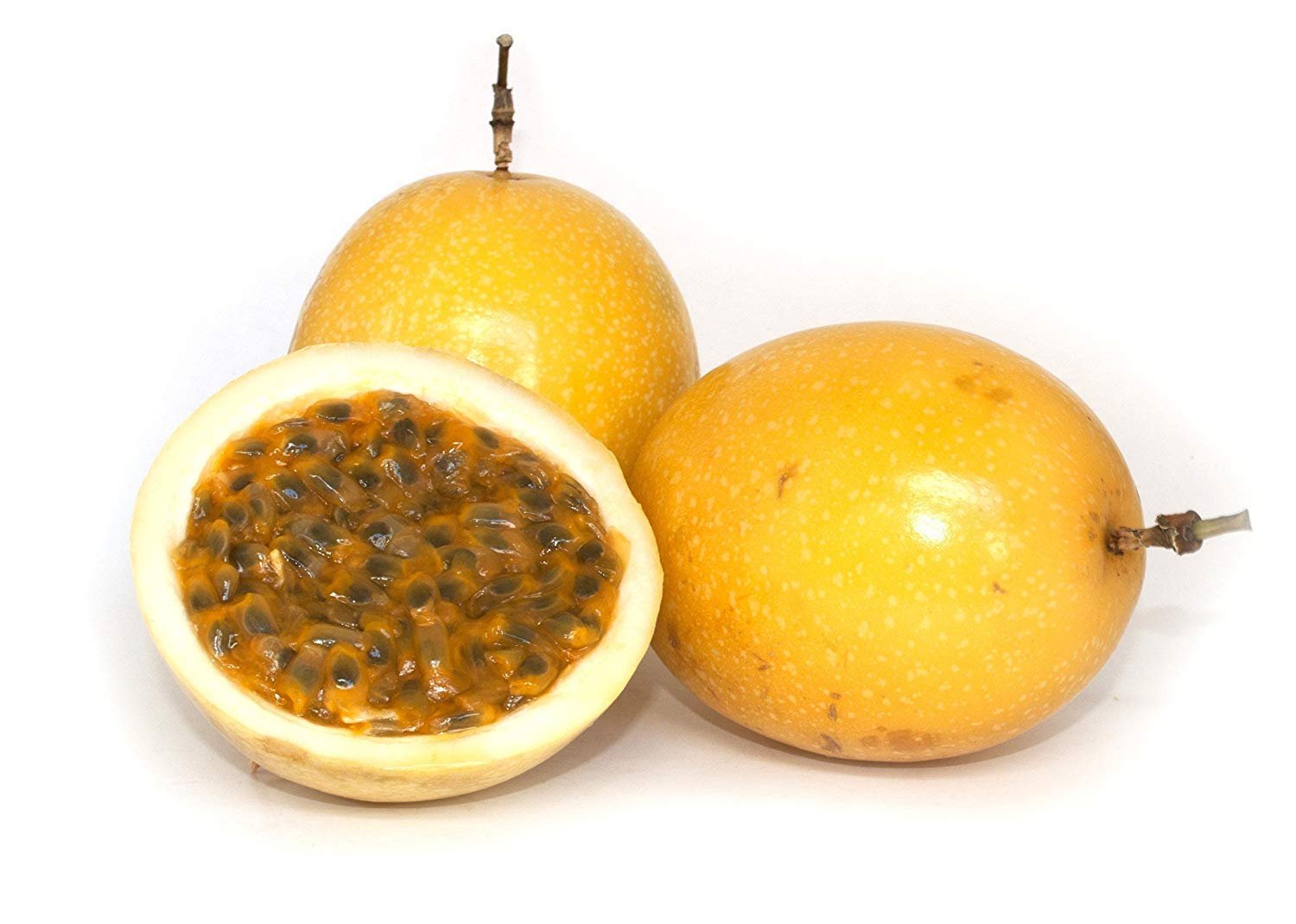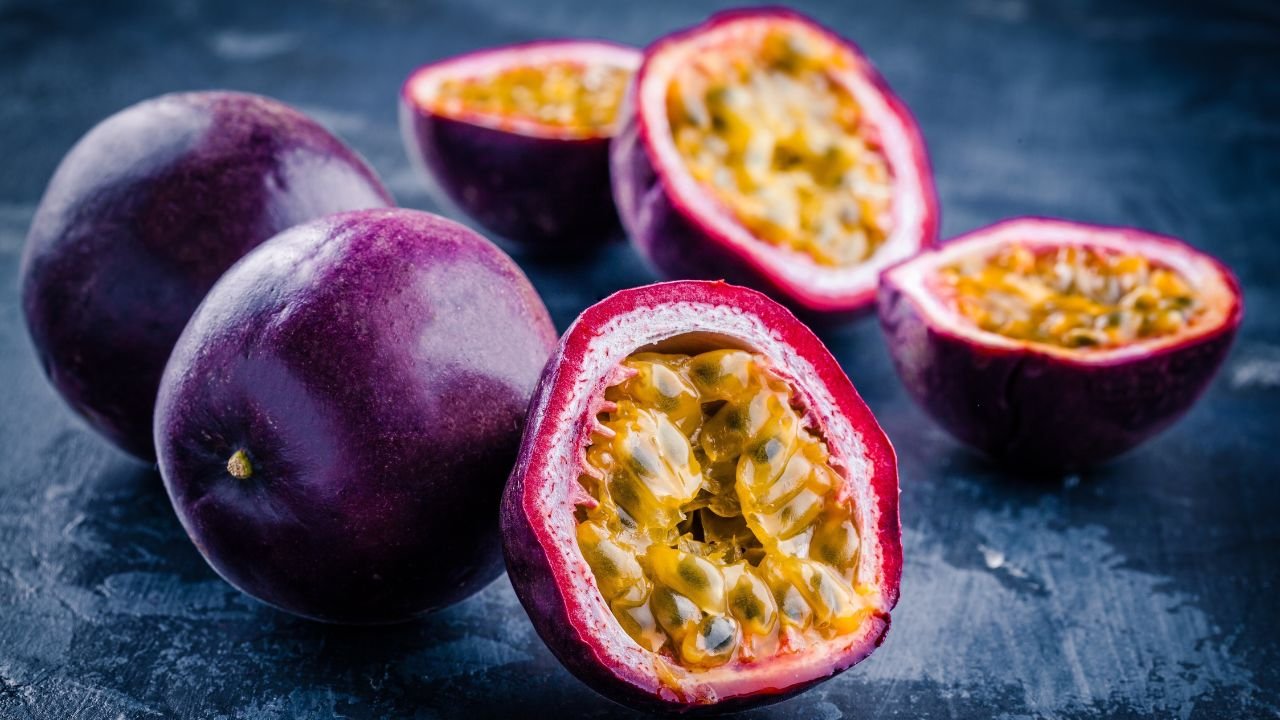Interesting Yellow Passion Fruit Benefits and Side Effects

What Is Passion Fruit?
Although passion fruit doesn’t appear exotic, it sounds that way. Initially, at least. It is found in tropical locations like as Australia, New Zealand, and Hawaii, growing on climbing passion flower vines. It has yellow or purple skin and appears small and egg-shaped from the exterior. Until you cut it in half, you might mistake it for a tiny lemon or plum.
It has a luscious yellow pulp loaded with crunchy seeds inside.
Priests in the 1500s believed that certain parts of the passion flower represented Jesus’ “passion,” or his suffering and death. This is how the passion fruit received its name. The fruit also bore the same name; it was also known as maracuja and granadilla.
Passion fruit has a particular scent that is frequently mimicked in candles and bath products. It tastes sweet and tangy. Just the pulp and seeds can be consumed, and even a small spoonful can provide numerous health advantages.
Varieties
Four primary varieties of popular edible passion fruits can be differentiated:
- purple passion fruit-(fruits of Passiflora edulisSims),
- yellow passion fruit (Passiflora edulis f. flavicarpa),
- sweet granadilla (Passiflora ligularis),
- giant granadilla (Passiflora quadrangularis)
Passion Fruit is a good source of:
|
Passion fruit (granadilla) |
|
|
Nutritional value per 100 g (3.5 oz) |
|
|
Energy |
406 kJ (97 kcal) |
| Carbohydrates | 23.4 g |
| Sugars | 11.2 g |
| Dietary fiber | 10.4 g |
| Fat | 0.7 g |
| Protein | 2.2 g |
| Vitamins | Quantity
(%DV) |
| Vitamin A equiv.
beta-Carotene |
8% (64 μg)
7% (743 μg) |
| Riboflavin (B2) | 11% (0.13 mg) |
| Niacin (B3) | 10% (1.5 mg) |
| Vitamin B6 | 8% (0.1 mg) |
| Folate (B9) | 4% (14 μg) |
| Choline | 2% (7.6 mg) |
| Vitamin C | 36% (30 mg) |
| Vitamin K | 1% (0.7 μg) |
| Minerals | Quantity (%DV† ) |
| Calcium | 1% (12 mg) |
| Iron | 12% (1.6 mg) |
| Magnesium | 8% (29 mg) |
|
Phosphorus |
10% (68 mg) |
|
Potassium |
7% (348 mg) |
|
Sodium |
2% (28 mg) |
|
Zinc |
1% (0.1 mg) |
|
Other constituents |
Quantity |
|
Water |
72.9 g |
|
Full Link to USDA Database entry |
|
|
· Units · μg = micrograms • mg = milligrams · IU = International units |
|
|
† Approximations of percentages are made using adult US recommendations. |
|

How to eat passion fruit
This tropical fruit’s vibrant, luscious flesh and seeds are only visible when the peel is cut or torn open.
You can consume the seeds along with the flesh and juice because they are edible.
Although the white film that separates the flesh from the rind is edible as well, most people avoid eating it due to its strong bitterness.
The uses for passion fruit are numerous and they are quite adaptable. Many individuals like to eat the fruit uncooked, just out of the skin.
Among the more well-liked applications for passion fruit are:
- Liquor: It can be used to produce a cordial to flavor water or squeezed through a sieve to generate juice that can be used for cocktails.
- Sweets: It’s frequently used in cakes and other sweets like mousse or cheesecake as a flavoring or topping.
- Regarding salads: It can be added to give salads a sweet taste and crunch.
- In yogurts: Combine it with plain yogurt to create a tasty snack.
Yellow Passion Fruit Benefits:
Rich in Nutrients: Packed with vital vitamins and minerals including potassium, dietary fiber, vitamin C, and vitamin A, yellow passion fruit is a nutritious powerhouse.
Antioxidant Properties: Packed with antioxidants, the fruit helps the body fight off free radicals, which may lower the risk of chronic illnesses and improve general health.
Boosts Immune System: Yellow passion fruit’s high vitamin C concentration helps the body fight off infections and illnesses by fortifying the immune system.
Aids in Digestion: The dietary fiber in passion fruit helps to maintain a regular bowel movement and prevent constipation, both of which are indicators of healthy digestion.
Heart Health: By controlling blood pressure, potassium in passion fruit helps to keep the heart healthy.
Anti-Inflammatory Effects: Passion fruit contains some substances that may have anti-inflammatory qualities, which may help to lessen inflammation in the body.
Enhances Skin Health: Antioxidants and vitamins work together to enhance skin health, giving the appearance of youthful skin.
Weight management: By encouraging a sensation of fullness and lowering total calorie intake, fiber content can aid in weight management.
Yellow Passion Fruit Side Effects:
Allergies: Passion fruit allergies can occur in certain people. Respiratory problems, skin rashes, swelling, and itching are examples of allergic reactions. If allergy symptoms appear, you should get medical help right away.
Interactions with Medications: Blood pressure and blood coagulation drugs, in particular, may interact with passion fruit. Before including passion fruit in your diet if you are taking medication, speak with your doctor.
Sugar Content: Although low in calories, passion fruit does have natural sugars in it. People who are watching how much sugar they eat, such as those who have diabetes, should be aware of how much they consume.
Stomach Upset: Eating a lot of passion fruit might occasionally result in gastrointestinal distress or upset stomach.
Pregnancy and Breastfeeding: To make sure passion fruit is healthy for their particular circumstance, expectant and nursing mothers should speak with their healthcare professional before incorporating it into their diet.

What advantages does eating passion fruit provide for your health?
Passion fruit has health benefits! It’s a great source of nutritional fiber and low in fat. One-half cup of raw purple passion fruit has 12.5 grams of dietary fiber, making it a reliable source of fiber.
Try these five simple methods to savor the deliciousness of passion fruit.
- Consume the pulp, seeds included.
A gelatinous pulp packed with seeds is found inside passion fruit. Although tart, the seeds are edible.
Using a spoon, remove the pulp from the passion fruit and transfer it to a bowl. Additionally, you can eat passion fruit pulp right out of the shell. You only need a spoon for this! To lessen the tartness, try sprinkling a little of your preferred sugar onto the pulp. Some also add cream.
- To create juice, strain the pulp of passion fruit.
The seeds of the passion fruit can be separated from the pulp if you would rather not consume them. This produces juice from fresh passion fruit. Pour the pulp of the passion fruit through cheesecloth or a fine strainer. on help push the juice through, apply pressure on the pulp using the back of a spoon. The juice tastes great either by itself or mixed into a smoothie.
- Nectar from passion fruit
The whole passion fruit—not just the pulp—is used to make passion fruit nectar. To make it, chopped passion fruit with its rind on is simmered in water until the fruit becomes tender. After that, the mixture is mixed, sweetened, and filtered (if desired).
- Coulis of passion fruit
A purée of strained fruit or vegetables is called a coulis. Without the skin, passion fruit coulis is prepared similarly to passion fruit nectar. It is made by filtering the seeds after boiling a mixture of sugar and passion fruit pulp for up to five minutes. Before boiling, some people stir in spices and vanilla beans to the pulp combination. You can serve passion fruit coulis over cheesecake, ice cream, or yogurt.
- Jam made with passion fruit
Top your morning toast or muffin with passion fruit jam and a bit of the tropics. Though there are a few more steps, the preparation is identical to that of other forms of jam. You must boil the pulp of the passion fruit, the lemon, and the sugar in addition to pureeing the inside meat and boiling the outer shells. The outcome is well worth the work. Mango and pineapple are two more fruits that some people mix into their passion fruit jam.
Frequently Asked Questions
What is yellow passion fruit?
Yellow passion fruit, scientifically known as Passiflora edulis, is a tropical fruit characterized by its round or oval shape, vibrant yellow rind, and unique, aromatic flavor. It is part of the passionflower family and is renowned for its sweet-tart taste.
How do you eat yellow passion fruit?
To eat yellow passion fruit, cut it in half, and scoop out the jelly-like pulp and seeds with a spoon. The pulp is the edible part, offering a sweet-tart flavor. It can be eaten on its own or used in various culinary applications, such as smoothies, desserts, or as a topping.
Can you eat the seeds of yellow passion fruit?
Yes, the seeds of yellow passion fruit are edible. While they have a slightly crunchy texture, some people prefer to suck on the seeds to extract the juice while consuming the pulp.

Pingback: List of Fruits from A-Z (in Alphabetical Order) 2024 - USANEWSPRINT